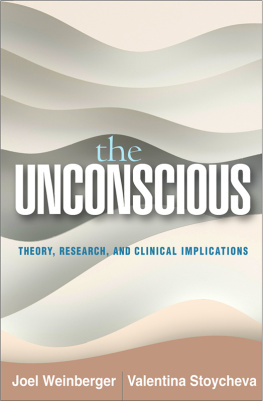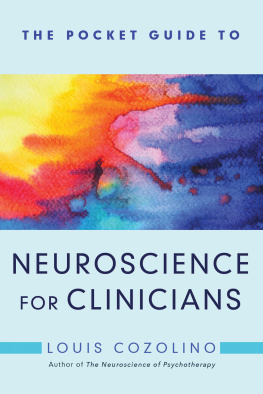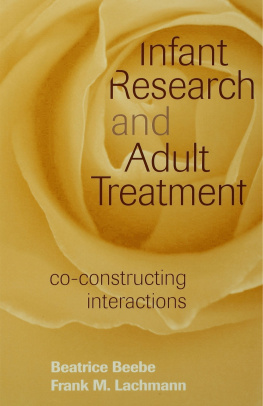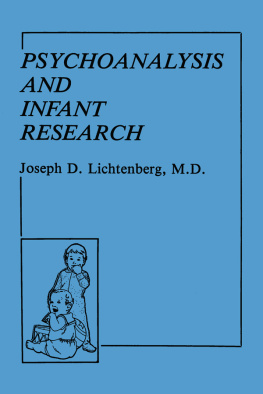
Infant Research
&
Neuroscience at Work
in Psychotherapy
EXPANDING THE CLINICAL REPERTOIRE
Judith Rustin

To Herb Rabin
The Wind Beneath My Wings
Contents
THE FIRST THANK YOU belongs to the psychoanalytic communities that afforded me the opportunities to study, learn, teach, and supervise. First and foremost my deepest gratitude goes to the Institute for the Psychoanalytic Study of Subjectivity and its founding faculty: George Atwood, Beatrice Beebe, Bernard Brandchaft, James Fosshage, Frank Lachmann, and Robert Stolorow. Each one of these original thinkers and master clinicians contributed to my theoretical and clinical development in countless ways. A special thanks belongs to Beatrice Beebe; she was the magnet that drew me to IPSS to study infant research and apply it to the clinical process. The Psychoanalytic Psychotherapy Study Center has provided me a forum for my ever-expanding ideas by inviting me to teach, supervise, and lecture.
Numerous professional individuals and groups have fostered my professional development and encouraged me to pursue my ideas. Special thanks go to Christina Sekaer for studying neuroscience with me and reading and editing parts of this book; she remains my go-to person for clarification of the science. I thank Barbara Eisold for her encouragement and support for this project from the beginning and her careful reading and editing of the text; Kenneth Eisold for his guidance at crucial moments in this endeavor and his ongoing encouragement and support; Peter Lessem, a long-time friend and colleague who has always been a vocal advocate of my clinical work; and the numerous students and supervisees I have taught who have challenged and pushed me to refine my thinking while applauding my ideasI needed both. A special thank you goes to Heather Ferguson, Eleanor Huber, and their respective patients. Each therapistpatient dyad contributed a clinical example that uniquely captured the essence of a specific concept. And finally, all the patients who trusted me with their most personal inner trials and tribulations. We grew and learned from each other.
Special thanks go to my daughter, Cara Rabin. As an infant she was the muse that started me on the journey of rethinking early development. As a young adult, she brought her creative writing skills to bear on the finished manuscript.
And finally, this book owes a special debt to Andrea Costella Dawson, my editor at W. W. Norton. Andrea invited me to submit this project to Norton. Subsequently, she steered it through its various iterations with never ending patience, tact, and respect. Thank you to Andrea and to all at Norton who contributed to this book.
IN 1971, I WAS A NEW candidate in a psychotherapy training program, struggling with George, a depressed young man in his mid-20s. George was transferred to me when his therapist, a senior supervisor, left the clinic. By then he had been in therapy twice weekly for 3 years. Georges sessions followed the same pattern. He comes in, sits down, and recounts his latest fights and upset with his wife. Within a few minutes, he begins to fidget; his eyes fill up and soon tears begin streaming down his face. I see and hear that he is upset. I verbally relate to his upset, but I feel nothing. I am a relatively young clinician, only 6 years out of graduate school and with only two jobs in training hospitals under my belt. But this experience of feeling no sympathy or empathy for a patients distress is new for me. I feel that there is something wrong with me. I am the relative beginner, taking over for a senior supervisor. I must be doing something wrong. I explore different avenues with George that might explain his distress and stir my own natural empathy for him. After 3 months of struggling with this issue, to no avail, with great trepidation I bring my difficulties to my supervisor. Fortunately, he is sympathetic and understanding. He tells me that in the short time hes known me, this lack of an authentic empathic response is very unusual. He suggests that I share my response with George and see where it goes.
In the next session, I anxiously tell George that I am having an unusual reaction to him. I can see by his tears and hear by his narrative that he is very distressed. Yet, I find myself without a spontaneous sympathetic response to him, and I am troubled by that unusual absence. I continue, Can you help me? I would like to feel more in sync with your distress. He smiles knowingly and says: I walk into this room, force myself to glue my eyes onto yours, I start talking, and then I leave the room! I am taken aback both by the nature of his response and the fact that George seems to know what I am talking about. I ask him where he goes when he leaves the room. He replies: Im not sure, to different places; mostly to memories of my childhood. Flying by the seat of my pants, I suggest to George that we make a contract. From now on, I ask him to signal me when he is about to leave the room. He agrees. And so began our successful and rewarding long-term psychotherapy journey together.
Following our contract, George signaled me when he was leaving the room. At first, he could only stay in the room with me for 5 minutes before he signaled that he was leaving. But now when he leaves the room, I go with him. At first he had trouble telling me where he was going. But, eventually, with my patience and some exploratory help, he was able to articulate where he was psychically. Invariably he had gone to a memory of his mother and some iteration of an experience with her, in which she unpredictably abused him verbally, psychologically, or physically. Now it was easy for me to stay with George and relate empathically to the pain and terror of the little boy who was being abused by an unstable and erratic mother. Georges 5 minutes of staying in the room with me stretched to 10 minutes, then 15 minutes, until after 3 years of my revisiting the memories of his early verbal and physical abuse when he left the room, he was finally able to stay in the room with me for the full 45-minute session.
This journey we took together resolved the terror of the transferencethat is, of being in a small room with a woman. It also helped him navigate the relationship with his wife so that her complaints and need to be listened to became less disruptive to him. George was now able to stay in the room with her as well. Through this very meaningful experience with George, I learned the importance of paying attention to and trusting how the two people, therapist and patient, in the room interact and influence each other. And, I came to understand the power of the nonconscious, nonverbal aspects of the therapeutic relationship before I knew the names, concepts, theories, or data to describe them.
I was originally trained during the 1960s and 1970s in the ego psychology tradition, in which the experiences of the individual were privileged. During the 1980s, I discovered Heinz Kohut and self psychology and later in the 1980s, intersubjectivity systems theory as conceived by Robert Stolorow and collaborators (Atwood, Brandchaft, and Orange). Both Kohut and Stolorow focus on the experiences of the individual in relation to others . Kohut eschewed drive theory and the structural model of the mind, shifting his theoretical emphasis to how lack of mirroring and attunement in the early childcaregiver relationship impacted the experience of self. Kohut (1971) located therapeutic cure primarily in the interaction between therapist and patient. In this new relationship the patient is able to activate aspects of thwarted development, build new psychic structures, and consolidate a sense of self that includes increased coherence, positive self-esteem, and increased vitality (Lessem, 2005). In order to create an environment that fosters this kind of relationship, Kohut proposed a listening stance of empathic immersion. This listening stance was originally defined in his seminal 1959 paper Introspection, Empathy and Psychoanalysis: An Examination of the Relationship Between Mode of Observation and Theory. Shortly before his death he rewrote this paper; it was published posthumously as Introspection, Empathy and the Semi-Circle of Mental Health (Kohut, 1982). Kohut defined his listening stance of empathic immersion as one in which the therapist enters the patients inner world by understanding the intrapsychic logic of the patients emotional life. For me, this repositioning from the outside observer of ego psychology to a participant experiencer of the patients inner world was an invaluable paradigm shift in my clinical practice. It radically changed the way I thought about clinical practice and the way in which I worked withand continue to work withpatients.
Next page













